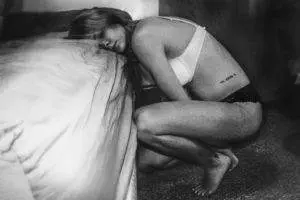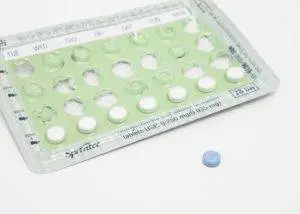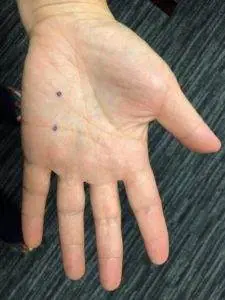By Xiaomei Cai, L.Ac., Ph.D., & Qineng Tan, L.Ac., Ph.D.

Our patients often ask us these questions: Why do I have heavy periods with severe, painful menstrual cramps that seem to be getting worse and worse? Why do I have spotting in between my menstrual periods? My ovaries hurt, I feel abdominal pain after sex; it even hurts to go to the bathroom. Excruciating period cramps, or period back pain during any part of the menstrual cycle, may mean a woman has endometriosis. Endometriosis is when menstrual tissue grows in places it shouldn’t. Acupuncture and TCM can help provide menstrual cramp relief, restore normal periods, and boost fertility.
Endometriosis is a fairly common condition, affecting about one in ten women during their reproductive years (age 15-49). If it goes untreated, endometriosis not only causes serious pelvic pain in women (pain lower abdomen), but can create a lot of scar tissue on the abdominal organs, negatively impacting fertility, and sometimes even continuing to cause problems after a woman has gone through menopause and no longer has a menstrual cycle.
What is Endometriosis? The thick, bloody lining of the uterus that develops every month–with the ultimate purpose of possibly nourishing a fetus, should a woman become pregnant– normally breaks down and flows out during the menstrual period. When a woman has endometriosis, this same tissue develops in places other than the inside of the uterus: on the ovaries or fallopian tubes, on the outside of the uterus, or even on the intestines or bladder. The overproduction of hormones created by this excess tissue is partly what causes painful periods, as well as internal bleeding.
Current conventional Western medicine generally treats endometriosis using pain medicine and oral birth control pills or Nupron, a drug that suppresses estrogen production, to control bleeding. Nupron prevents the period from coming, so it controls most of the menstrual pain of endometriosis and prevents the further growth of menstrual tissue. However, when a woman stops taking these hormone suppressant medications, the condition will most likely come back. Surgery can remove patches, nodules, and cysts, but endometriosis can still come back easily when the root cause has not been addressed. TCM gives us a way to treat and prevent endometriosis at its source, at the same time as providing natural pain relief.
Top 10 Signs and Symptoms of Endometriosis
The symptoms of endometriosis can be serious and debilitating, especially when a woman has her menstrual period. However, the pelvic pain and excessive bleeding associated with endometriosis can occur at any time during the month.
- Severely painful menstrual cramps (dysmenorrhoea)
- Heavy bleeding during period; period lasts a long time
- Spotting in between periods
- Pain during ovulation (mittelschmerz); pain in lower right abdomen, pain in lower right side, pain in lower left abdomen, pain in lower left side
- Pain during or after sexual intercourse (dyspareunia)
- Pain when urinating or defecating, perineum pain
- Chronic pelvic pain
- Chronic low back pain, hip pain
- Fatigue
- Infertility

The severity of pain does not necessarily correspond to the size or spread of the endometrial tissue. Small nodules can cause severe pain, while massive adhesions or large cysts can cause minimal pain. Pain can occur any time, not only during menstruation.
Endometriosis can have a significant impact on a woman’s quality of life. Not only is the constant, serious pain exhausting, but painful sex, low libido, and anxiety about fertility can put a strain on relationships. A woman with endometriosis may also experience depression. The severe pain caused by endometriosis should not be ignored, as the condition can cause lasting damage, not only to the reproductive organs, but potentially also to the digestive organs and other abdominal tissues.
Endometrial patches or lesions may respond to the stimuli of the female hormones produced by the ovaries, causing them to become inflamed and/or shed bloody tissue during the menstrual period. During the period, the uterus bleeds, and the other patches of tissue bleed, too. They can also begin to produce their own hormone secretions, causing them to bleed at irregular times. This tissue can cause organs in the pelvis to “stick” to each other and create scar tissue or nodules on the organs over time.
Endometrial patches can grow nerve tissue, as well, which produces the intense sensations of pelvic pain, abdominal bloating, and cramps. Women with endometriosis often have cysts on the ovaries, because the endometrial tissue outside of the uterus responds to hormones. The body absorbs water from these cysts, and the bloody tissue turns into a thick, syrupy, brown liquid; this is why they are sometimes referred to as “chocolate cysts.”
When a woman has endometriosis, she almost always shows compromised hormone issues, in addition to menstrual pain. The cycle is off, usually showing luteal phase deficiency– when the luteal phase is 12-14 days instead of the typical 14 days from ovulation to the start of the period. This is due to ovarian cysts affecting the function of the ovaries.
Patches or nodules can also form in other parts of the body, in rare cases, causing nosebleeds or chest pain because tissue has migrated outside the pelvic area.
What Causes Endometriosis?
The causes of endometriosis are not currently understood by medical science. Women whose mothers or other female relatives have had endometriosis do seem to have a higher risk for having it themselves, so it is possible that there is some genetic marker that causes some cells outside the uterus to develop into endometrial cells. The most likely theory is that a backflow of some menstrual blood travels into the fallopian tubes and from there migrates into other areas of the pelvis, and in some cases, even other parts of the body.

Many women have a hard time finding a proper diagnosis for their endometrial pain. Menstrual pain has been normalized to such an extent that it is often ignored, or just accepted, by both doctors and patients. Usually many other possible causes of the pain have to be ruled out before a woman is offered diagnostic testing especially for endometriosis. The usual type of pelvic exam is generally not helpful for spotting endometriosis. Ultrasound may detect large lesions, but imaging is not clear enough to see all endometrial growth. Getting a confirmed diagnosis involves a somewhat invasive laparoscopic procedure to detect cysts, lesions, or scar tissue. This is unfortunate, because early detection is the best way to prevent endometriosis from spreading and getting worse.
Conventional treatment for endometriosis focuses mainly on pain management with analgesic medications, and using hormones (birth control) to prevent further growth. Clearly, this is not helpful for women who want to get pregnant. When a woman is concerned with her fertility, and wants to conceive, then laparoscopic surgery to remove growths may be indicated.
How Does Acupuncture Treat Endometriosis?
According to TCM theory, endometriosis is considered a form of blood and Qi stagnation. We might classify this type of problem as Zheng Jia, in which blood stasis causes clotting or the formation of masses. PCOS, ovarian cysts, uterine fibroids, and reproductive cancers would also fit in this category. Other patterns can also cause dysmenorrhea (painful periods) and contribute to endometriosis.
Problems with the female reproductive system can present in a variety of ways:
- Qi stagnation with blood stagnation
- Yang deficiency with blood stagnation
- Qi sinking with blood stagnation
The reason for stagnation can be a blockage of liver Qi, often associated with feelings of anxiety. This is why stress management is so important. Blockages can also be caused by being in a cold environment, not dressing warmly enough, or drinking or eating cold things during the menstrual period. During the period, the organs need to be open; allowing the pelvic area to become too cold can restrict the flow, create stagnation, and contribute to the development of cysts, endometriosis, and/or fibroids.
Carefully considering the overall presentation of symptoms, an acupuncture practitioner will seek to determine the root cause of the Qi and blood stasis and develop a treatment protocol aimed at clearing stasis, increasing circulation, nourishing the uterus and ovaries, and regulating dysfunctional energies in other organs, such as the liver, kidneys, and spleen. Moxibustion may also be used to help bring heat energy to areas where stasis is caused by cold.
Acupuncture treatment in conjunction with individually formulated Chinese herb supplements and other modalities such as cupping is used to help move Qi and blood. Herbs help to bring in nutrients that people would not otherwise get in their diet; nourishing the ovary follicles, in particular, is vital for helping women with endometriosis overcome infertility problems.
A clinical trial at a hospital in China compared two groups of women with endometriosis: one group was given the synthetic steroid mifepristone, intended to reduce progesterone action. The other group was treated with acupuncture and herbs. The patients were checked via ultrasound to detect progress. The efficacy rate for reduction of endometrial growth was the same in both groups, suggesting that TCM methods were just as effective as steroids for improving the symptoms of endometriosis and halting its spread.
A systematic review of ten trials concluded that acupuncture treatment was effective for reducing endometriosis pain.
Both of the studies cited here also noted, via blood tests, a reduction in CA-125 levels in the women receiving acupuncture. Elevated CA-125 is a marker not only for more advanced stages of endometriosis and increased pelvic pain, but also for various types of female reproductive cancers.
Keep in mind that the effects of acupuncture treatment are cumulative; more benefits will be felt with regular treatment. There is no cure for endometriosis, but acupuncture and TCM can help significantly reduce pain, prevent the further development of endometrial tissue and scarring, and help improve fertility for women who want to start a family.
TCM not only treats symptoms and pain, but helps relieve stress, and increases the flow of Qi and blood, helping to manage all aspects of female reproductive health.
During childbearing age, the best way to help get rid of or manage endometriosis is to carry a pregnancy to term, because during pregnancy there is no period. When the ovaries and menstrual cycle get ten or so full months of resting time, there is a good potential for cysts, nodules, and lesions to go away. Good care will rid the body of the stagnation. Acupuncture and TCM allow us to treat endometriosis and infertility simultaneously, if pregnancy is a woman’s goal.
Top 5 Tips for Natural Relief of Endometriosis

In addition to acupuncture and TCM treatment, here are some natural remedies for endometriosis pain that you can try at home:
- Apply heat – warming energy can help relieve the painful symptoms of endometriosis. An electric heating pad, hot water bottle, or sock filled with rice and heated in the microwave, then applied to the abdomen or lower back can help relieve cramps.
- Drink plenty of water – dehydration intensifies cramping, so be sure to sip clean water throughout the day. Warm water particularly can help to thin the blood and keep it flowing smoothly.
- Plan ahead to give yourself extra down time – tracking your cycle and symptoms is important. When you know ahead of time that you are likely to be experiencing pain, plan to give yourself time off to rest. Taking extra pain medications or pushing through pain will only cause more exhaustion and anxiety.
- Period care – we recommend you use pads or period underwear more often than tampons during the menstrual period; use tampons only when the situation requires it (swimming, etc.). Also, do not engage in sexual intercourse during the heavy flow days of the period. Avoid anything that could block or reverse the flow of menstruation.
- Avoid caffeine and alcohol – some studies have shown that women who consume more of these substances are at higher risk for endometriosis (and many inflammatory conditions). While this doesn’t mean there is a direct link, it is still better to keep your intake of coffee and wine to a minimum. Avoid toxins in your food – food additives, pesticides, and chemicals in meat can trigger endometriosis symptoms. Focus on eating whole, natural foods and getting plenty of healthy Omega-3 fats from nuts, avocados, and high-quality fish or plant oils.
Above, there is also a good acupressure point to use when you are having painful cramping during menstruation, or to help relieve nausea from morning sickness.
Acupuncture Near Me for Endometriosis
At Art of Wellness, we have over 30 years of experience in managing women’s health issues. Our education and early practice gave us the opportunity to work with leaders in cutting-edge integrative medicine for women. Since 1997, we have worked with the top infertility ART providers in Los Angeles to give women the best in reproductive health care and fertility treatment. If you or someone you know is struggling with the pain of endometriosis or infertility, do not hesitate to call us and get started with an initial consultation.
*This article is for education from the perspective of Traditional Chinese Medicine only. The education provided by this article is not approved by FDA to diagnose, prevent, treat and cure human diseases. It should not stop you from consulting with your physician for your medical conditions. Traditional Chinese Medicine is based on Qi, which is an invisible force that usually cannot be observed by modern science. Because science focuses on testing ideas about the natural world with evidence obtained through observation, these aspects of acupuncture can’t be studied by science. Therefore acupuncture and Chinese herbs are often not supported by double-blind, randomized trials, and they are considered alternative medicine therapies in the United States.
